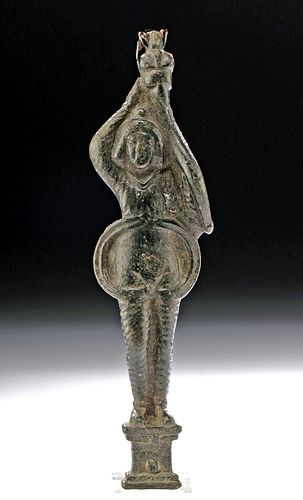Roman Bronze Figural Latch Depicting Attis
Lot 59b
About Seller
Artemis Fine Arts
686 S Taylor Ave, Ste 106
Louisville, CO 80027
United States
Selling antiquities, ancient and ethnographic art online since 1993, Artemis Gallery specializes in Classical Antiquities (Egyptian, Greek, Roman, Near Eastern), Asian, Pre-Columbian, African / Tribal / Oceanographic art. Our extensive inventory includes pottery, stone, metal, wood, glass and textil...Read more
Estimate:
$2,500 - $5,000
Absentee vs Live bid
Two ways to bid:
- Leave a max absentee bid and the platform will bid on your behalf up to your maximum bid during the live auction.
- Bid live during the auction and your bids will be submitted real-time to the auctioneer.
Bid Increments
| Price | Bid Increment |
|---|---|
| $0 | $25 |
| $300 | $50 |
| $1,000 | $100 |
| $2,000 | $250 |
| $5,000 | $500 |
| $10,000 | $1,000 |
| $20,000 | $2,500 |
| $50,000 | $5,000 |
| $100,000 | $10,000 |
| $200,000 | $20,000 |
About Auction
By Artemis Fine Arts
Feb 13, 2020
Set Reminder
2020-02-13 10:00:00
2020-02-13 10:00:00
America/New_York
Bidsquare
Bidsquare : Exceptional Antiquities, Asian, Ethnographic
https://www.bidsquare.com/auctions/artemis-gallery/exceptional-antiquities-asian-ethnographic-4848
An important one-day auction featuring museum-worthy examples of Egyptian, Greek, Roman, Etruscan, Near Eastern, Far East / Asian, Pre-Columbian, African / Tribal, Oceanic, Native American, Spanish Colonial, Russian, Fossils, Ancient Jewelry, Fine Art, so much more! Artemis Fine Arts info@artemisgallery.com
An important one-day auction featuring museum-worthy examples of Egyptian, Greek, Roman, Etruscan, Near Eastern, Far East / Asian, Pre-Columbian, African / Tribal, Oceanic, Native American, Spanish Colonial, Russian, Fossils, Ancient Jewelry, Fine Art, so much more! Artemis Fine Arts info@artemisgallery.com
- Lot Description
Roman, Eastern Mediterranean, Imperial Period, ca. 2nd to 3rd century CE. Finely cast via the lost wax (cire perdue) method, a solid bronze latch depicting Attis, the Phrygian god as well as consort to Cybele, the Mother Goddess, and worshipped throughout the Roman Empire where he was understood as a solar deity during the 2nd century CE. The sculptor of this piece has created an explicit statement. The god holds both of his arms above his head with a serpent-like creature to the left, while his garment is wide open so as to reveal his abdomen and genitals, conjuring the myth in which Attis emasculated himself in a mad frenzy. There is an integral suspension loop at the top as well as an integral loop for a lock behind Attis' integral pedestal. A marvelous piece replete with outstanding artistry and intriguing iconography. Size: 6.25" H (15.9 cm); 6.875" H (17.5 cm) on included custom stand.
According to a Phrygian legend, Attis was an attractive youth born to Nana, the daughter of the river Sangarius, and the hermaphroditic Agdistis. Agdistis, who had fallen for Attis, struck him with frenzy just when he was about to get married. Attis inflicted by this madness in turn castrated himself and died. Agdistis then asked Zeus to grant his wish that the body of the youth would never decay or waste. Ultimately, Attis was regarded as a vegetation god, who via his self-mutilation, death, and resurrection metaphorically symbolized the fruits of the earth, which annually see their demise in winter only to rise again in the spring.
Provenance: ex-Chayette & Cheval auction, Paris, France, lot 103; ex-private French & American collection, New York, New York, USA, acquired in the 1990s to 2000s
All items legal to buy/sell under U.S. Statute covering cultural patrimony Code 2600, CHAPTER 14, and are guaranteed to be as described or your money back.
A Certificate of Authenticity will accompany all winning bids.
We ship worldwide and handle all shipping in-house for your convenience.
#152788Intact and excellent. Some encrustation on verso. Rich, dark green patina and scattered russet brown areas. Chayette & Cheval label on lucite base.Condition
- Shipping Info
-
All shipping is handled in-house for your convenience. Your invoice from Artemis Gallery will include shipping calculation instructions. If in doubt, please inquire BEFORE bidding for estimated shipping costs for individual items.
-
- Buyer's Premium



 EUR
EUR CAD
CAD AUD
AUD GBP
GBP MXN
MXN HKD
HKD CNY
CNY MYR
MYR SEK
SEK SGD
SGD CHF
CHF THB
THB















